| The Mercedes
way.

Mercedes-Benz are leaders in
every innovative field of automotive technology.
At the same time, they still adhere to those traditional
principles which continue to prove their value, despite the
inevitable changes brought about by the course of time. This
means that all the advanced technology that Mercedes-Benz
are pursuing, with a great deal of creativity and financial
investment, is subjected to standards of value which have a
timeless validity. It is this rather unusual combination of
innovation and tradition that results in the special, unique
course that Mercedes-Benz follow when developing their cars.
"Why donīt they just say that in simple terms?" This, or
words to this effect, is what Mercedes drivers and potential
Mercedes owners have often said, and written, to us. What
they mean is that those basic facts about Mercedes-Benz that
are actually essential when forming an opinion, and in
deciding whether or not to buy a Mercedes, often get lost in
a flood of detailed information. For this reason we are
prefacing this brochure with the basic facts about the
company and the cars with the three-pointed star, briefly
and, we hope, "in simple terms".
Quality for the future
Progress has no purpose if it
does not produce new qualities - at a higher standard of
quality. That is exactly what Mercedes-Benz is all about.
More safety, even under more difficult conditions.

Durable quality, to secure value retention. For instance
electronically controlled, long-lasting cavity sealing by
means of special wax.
Even more effective accident
protection systems. Comfort that genuinely reduces stress
levels and increases motoring pleasure. Effortless
performance, with a high degree of economy and exemplary
environmental acceptability. More features to cater for
individual tastes. And a range of practical service
facilities to eliminate the problems and leave you with just
the enjoyment.
This is what you are entitled to demand from progress, but
only from the sort of progress that is invisibly linked with
quality. And if, despite all our efforts, we occasionally
still make a mistake, because we are after all human, we
will redress that error. Because for us, the quality of
progress is more than a mere claim. It is a promise.
We are determined to be
unsurpassed in safety
Mercedes-Benz have been a
fundamental driving force in the development of automotive
safety. Many of our safety features have become the basis
for this legislation, others have been adopted in principle
by other manufacturers.
It all began exactly 50 years ago with the Mercedes-Benz
"Experimental car no. 1", which contained the first specific
safety elements.
The lead that this gave Mercedes-Benz has always been
maintained, right up to the present day.
A few of the Mercedes-Benz
milestones:
|
1951 |
|
The first safety bodywork in
the world (from 1953 in the MB 180). |
|
1959 |
|
The first collision and
roll-over tests. Interiors without sharp projections go
into series production. |
|
1967 |
|
Introduction of the safety
steering system. |
|
1978 |
|
ABS becomes available for
the first time. |
|
1980 |
|
The most frequent kind of
frontal impact, the offset collision, is taken into
account in the design of the car (only by Mercedes). |
|
1981 |
|
Electronically controlled
driverīs airbag and belt tensioner. |
|
1982 |
|
Multi-link independent rear
suspension. |
|
1985 |
|
Front seat belt tensioners
standard in all models. |
|
1986 |
|
Electronically controlled
automatic traction control systems, ASD, ASR, 4MATIC. |
|
1987 |
|
An airbag for the frontseat
passenger becomes available for the first time. |
|
1989 |
|
Automatic roll-over bar (on
the SL). |
Pioneers in environmental
technology
When catalytic converters
were still only the subject of lively public debate,
Mercedes-Benz took action.
The electronically controlled three-way catalytic converter
has been available since 1985. In Germany, Mercedes-Benz
became the first car manufacturers to fit three-way
catalytic converters as standard in all petrol-driven models
at the end of 1986.
All petrol-driven Mercedes-Benz cars from 1980 onwards can
be retrofitted with an open-loop catalytic converter.
For Mercedes-Benz, the determining factor was not legal
stipulations but the availability of unleaded petrol in
sufficient quantity.
Well within particulate
limits
In respect of gaseous
pollutants, Mercedes-Benz diesel cars are today at least as
good as catalytic converter petrol-driven models.
In particulate emissions, our diesels more than meet the
strict limits which already apply in the USA and which are
planned for Europe.
Since 1949, the proportion of particulates in the exhaust
gases of Mercedes-Benz diesel cars has been reduced by more
than 85%.
Fuel consumption reduced
In the last 10 years
Mercedes-Benz have reduced fuel consumption by 25% (the
average for all models).
Lower fuel consumption also means lower emissions of carbon
dioxide (CO2), which is said to be responsible
for the greenhouse effect.
High performance,
Mercedes-style
Four-valve engines were
around decades ago. It is Mercedes who have made real
progress with them. By means of electronically controlled,
automatic adjustment of the inlet camshaft, these engines
now develop powerful torque even at low and medium engine
speeds, while unleashing the full 162 kW/220 bhp potential
of their six cylinders in the upper speed range.
Optimum enginee efficiency is achieved by the fact that the
camshaft is rotated by a specific amount so as to arrive at
the most effective valve opening times in each engine speed
range.
The result, smooth-as-silk yet powerful acceleration, from
the bottom all the way to the top. Depending on the model
and the transmission - five-speed sports gearbox (standard),
four-speed automatic or the completely new five-speed
automatic (optional extra in the 300 CE-24 and 300 SL-24) -
acceleration times from 0 to 100 km/h range from 7.7 to 8.3
seconds.
Sufficient reserves of power to provide security for you and
for other road users.
With, at the same time, considerably reduced specific fuel
consumption and further improved exhaust emission
characteristics.
The sporty side to
Mercedes quality
It is not Mercedes style to
promote aggressive road behaviour, but rather to encourage
performance driving within the bounds of reason and common
sense. The Mercedes-Benz Sportline models conform to this
concept.
Having already proved exceptionally successful in the 190
series, Sportline versions of the saloons and estate cars in
the 200 to 300 series are now available.

Sports suspension, lower
body, wide tyres, sports seats and in some cases
considerably increased performance, make an attractive
contribution towards fulfilling the individual wishes of
drivers.
Intelligence as standard
For us, the best solution is
preferable to the second best, as a matter of principle.
Luckily, Mercedes drivers see things the same way. Even if
this requires more in terms of sophistication and, of
necessity, more time and money. But it is the final result
that matters, after all.
And this result is expressed in features such as the superb
multi-link rear suspension; the highly developed ABS;
engines with electronic idle-speed control; fuel pre-heating
in the diesels; hydraulic valve clearance compensation;
extremely hard-wearing single-belt drive for all
auxiliaries; height-adjustable seat belts with electronic
belt tensioners at the front; electronic temperature control
for the interior; heated screenwash system and spray
nozzles; driverīs seat also adjustable for height and seat
cushion angle; pneumatic headlamp range control; three sun
visors; two heated exterior mirrors; adjustable from the
inside (nearside mirror electric); automatically closing
tailgate on the estate cars; and the automatic belt guide in
the coupés.
And what does this selection from the list of standard
features prove? It merely shows the slightly greater amount
of intelligence that goes into the design, with the effect
of higher practical value for you.
All that glitters is not
progress
Finding out about all that is
possible, but only actually doing that which makes sence.
That is the task of our research departments.
Exciting innovations which do not solve any problems, or
even create new ones, are not what we call progress.
Electronics, cybernetics and new materials open up whole new
dimensions for automotive and traffic technology. We are
hard at work in these areas. Making the outmost use of the
exceptional technological potential within the Daimler-Benz
group.
But we examine closely their real benefits to people and
their acceptability to society and the environment.
We are working on electric propulsion, hydrogen and solar
technology, energy and raw-material-saving technology, and
on the development and testing of new materials with
made-to-measure characteristics, such as plastics, ceramics,
fibre-reinforced carbon and shape-memory materials.
 |
With the most modern
driving simulator in the world, we examine and test new
engineering under conditions close to real life. |
We are using artifical
intelligence so as to reduce or eliminate human error when
it comes to recognising traffic situations and reacting
correctly and quick enough.
"Thinking" suspension and rear-wheel steering, engines with
more power yet lower fuel consumption, further reduction of
exhaust emissions and the development of recycling
techniques are also part of our research programme.
Welcome to Mercedes-Benz
You can feel comfortable with
Mercedes-Benz. Not just happy with your car, but also with
our service and with our people.
Your pleasure in your Mercedes should be marred as little as
possible by servicing needs or by rare - we are pleased to
say - breakdowns or repairs.
To achieve this, we offer a meticulously co-ordinated system
of warranty and assistance, available to every Mercedes
driver.
This system includes new car warranty, emergency and
out-of-hours servicing, preservation of a customerīs
mobility when repairs take a long time, and the unique
Mercedes Touring Guarantee which provides assistance and
refunds of costs in the case of a breakdown, valid in 22
European countries (for all Mercedes-Benz cars registered as
new since September 1989).
A challenge accepted
After a break of over 30
years, Mercedes-Benz are back in the business. The business
of competition in innovative ideas, in the demonstration of
the highest expertise and efficiency under the toughest of
conditions.
With eight victories in 1989, the Silver Arrows won the
Sports Prototype World Championship for Mercedes-Benz.
In this way, a modern challenge has been met in traditional
Mercedes fashion. With the right spirit, superior technology
and a unique team.
Naturally, the Sauber Mercedes car is used for a wide
variety of research purposes. The 720-bhp enginge, for
instance, is based on the five-litre V8 engine used in the
Mercedes-Benz S-class and SL models.
The development of technology which both boosts power and
reduces fuel consumption, the testing of new lighweight,
high-strength materials and the application of the latest
transmission, collation and evaluation systems for vehicle
data - all this and many other things will benefit future
Mercedes production cars.
FREEDOM OF MOVEMENT FOR
INDIVIDUALS
The T-series models are as
individualistic as their drivers. Yet the space they
provide, and the flexibility of that space, reflect only one
aspect of this particular attitude to cars and to life.
Because Mercedes-Benz have combined the practicality of an
estate car with the elegance, generous comfort and specific
quality of a Mercedes saloon. And this has made the Mercedes
T-series the epitome of exclusive versatility. With about 30
new refinements, these successful models are now even more
attractive than before. More dynamic outside. More exclusive
inside. With significantly enhanced ride comfort and in some
cases considerably improved performance. And the T-series
range has been enlarged by the addition of a new top model,
the 300 TE-24 with innovative four-valve technology, and the
new Sportline versions. Which means this range can now
provide any desired level of performance, as well as
catering for those who like a more sporty flair.
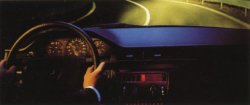
The exterior has a more
co-ordinated, powerful look. All models have new,
distinctive side mouldings. The front and rear aprons,
together with the large bumper units, are colour-matched.
The exterior mirrors are painted in the same colour as the
bodywork and the wheel trims have been redesigned.
Integrated stainless-steel strips underscore the elegance of
the outstanding shape.
Technical improvements have also been made. Optimised gear
ratios in all models with five-speed gearboxes (whether
standard or optional). To improved smoothness and ride
comfort even further, a number of details have been modified
in the power train. In addition, all models over two litres
now have a new two-mass flywheel, which reduced vibrations,
and larger-diameter rear axle shafts.

Without taking up any more space on the road or in the car
park, the T-series models offer considerably more in the way
of usable interior space - in combination with the style of
an exclusive saloon.
Experience more quality
A refined atmosphere and the
exclusive comfort are part of the versatility of the
T-models. Something you can feel right from the outset. And
your enjoyment will increase with every kilometre. Even at
higher speeds the careful noise-damping allows you to
converse without raising your voice - due in part to the
result of the accurate assembly and the high-quality
materials and linings throughout the car. The electronically
controlled ventilation and heating system can be adjusted
separately for the driver and front passenger; it works
quickly, quietly and without causing any draughts. And the
new features make the comfort even more luxurious. The newly
designed seats have better fluting, firmer upholstery and
more clearly contoured side sections, so they now offer even
greater comfort on long journeys; relaxing support, they
feel different. The same applies to the rear seats, with
room for three adults. The seat belt height adjustment at
the front and the belt buckles in the rear are now even more
convenient to use. Pockets on the backrests of the front
seats create more stowage space. Additional noise
insulation, partly due to the thicker side windows, makes
the interior even quieter.
Fine wood trim, new fabrics and patterns for the seat
coverings and door linings round off the general ambience. A
large number of new details which clearly enhance the
quality.
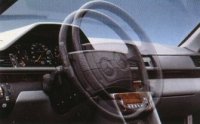
Features of particular
interest to the driver. The driverīs seat is fully
adjustable, including seat height and squab angle
(optionally extra, electrically adjustable seat and steering
wheel with a memory feature).
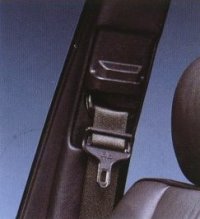
Seat belt height adjustment,
electronically controlled belt tensioners. Recessed
panoramic windscreen wiper (clears 86% of the screen).
Rearscreen wiper with automatic cut-in in reverse gear.
Third sun visor above the rear-view mirror. Both exterior
mirrors heated and adjustable from the driverīs seat.
Power-assisted steering. Rev counter (optional extra in the
200 T and 200 TD). Headlight warning buzzer. Warning lamps
for brake fluid, engine oil, coolant and screenwash fluid
levels. Function monitors for all exterior lights and ABS.
Brake pad wear indicator. Halogen foglights. Graduated
headlamps range adjustment.
Look forward to driving
Driving as a positive
experience - conscious pleasure in the dynamism and
responsiveness of these cars, starting with the good feeling
of always being in full control. The meticulous design of
the driverīs area allows you to drive with enjoyment.
Relaxed - and therefore safe. All the information-giving
instruments are clearly marked and grouped according to
their significance. All the controls can be identified
instantly, and can be operated smoothly with one hand.
Everything helps the driver to act and react quickly and
safely. Exemplary design features, right down to the
details. For example the hazard warning light switch, which
stands out clearly on the centre console. The glove
compartment lock, positioned where the driver can reach it
easily. The rear screen wiper, which operates automatically
when reverse gear is engaged, if the front wiper is on. And,
not least of all, all elements are designed to enhance
active and passive safety. The dashboard does not project
into the interior, for instance, and the pedals pivot away
from the danger zone in the event of a collision. To mention
but a few points.
Active for your safety
The unique handling
characteristics of the T-series are due to the design of the
high-precision suspension, with superbly co-ordinated
components. Multi-link independent rear suspension. Shock
absorber strut independent front suspension. Accurate power
steering system. Servo-assisted dual-circuit braking system,
supplemented by ABS. Self-levelling rear-suspension, to keep
the car horizontal no matter what the load and to provide an
ideal balance between ride comfort, safe road-holding and
reassuring stability.
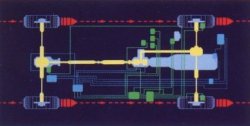 |
4MATIC:
Electronically controlled, automatic four-wheel drive
for better roadholding in extreme conditions. |
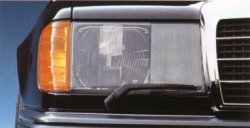 |
The wash/wipe system
(optionally extra) always ensures full headlamp power. |
 |
The multilink independent
rear suspension. For superb straightline stability,
absolute tracking and steering precision. |
Active safety compromises all
the features of a car which help you to master critical
situations. That also includes the comfort, to help you stay
fit and alert. The ergonomic design of the controls,
allowing you to react quickly. The lighting and visibility,
giving you the best possible view. In these areas, every
Mercedes offers exemplary features. And the passive safety
systems are equally as exemplary, so as to give you and your
passengers maximum protection from injury if the worst
should come to the worst. The passenger compartment will
retain its shape to a large extent, even if impact energy is
very high. The interior has yielding surfaces throughout.
The electronically controlled belt tensioners represent
todayīs most effective restraint system. In addition, the
potential of intelligent electronics is also exploited. ABS
(standard), the Airbag, ASD, ASR and 4MATIC provide you with
systems which "think" and act independently. They analyse
the situation with their responsive sensors, make a decision
in keeping with the situation and react within fractions of
a second. And do this measureably better than a human being
ever could.
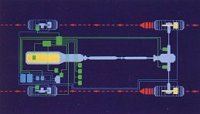 |
ASR, acceleration skid
control is now available in all six-cylinder, petrol
driven models with automatic transmission (optional
extra). ASR meters tractive power fully automatically
and prevents the driven wheels from spinning or the rear
of the car from breaking away due to excessive
acceleration. |
 |
Electronically controlled
belt tensioners for both front seats. In the event of an
impact the seat belts are pulled taut in a fraction of a
second, retaining the driver and front-seat passenger
earlier and more securely. Additional safety that comes
as standard with Mercedes. |
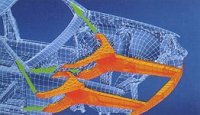 |
One of the results of
Mercedes-Benz safety research. In an offset frontal
collision - the most common form of accident - a
specially designed forked member structure at the front,
in the area of the fire wall, helps to retain the shape
of the interior to the greatest possible extent. |
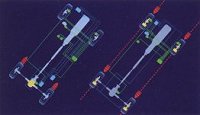 |
ABS is one of the standard
safety features in all models. ASD, automatically
locking differential, prevents the driven wheels from
spinning on slippery road surfaces (optional extra).
Both systems were developed by Mercedes-Benz to the
stage where they could be made on a large scale. |
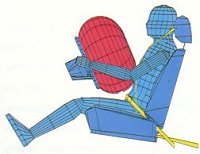 |
With the Airbag,
Mercedes-Benz have developed a highly efficient
protection system that has proved its functional
realibility many times over. To the present day, over
500.000 Airbags have been fitted. The driverīs Airbag is
in the steering wheel, the front passengerīs Airbag
where the glove compartment usually is. |
Some of the main safety
features: - High-strength passenger compartment - survival
space remains largely intact even in the event of a
roll-over, lateral impact or asymmetrical front-end
collision. Door locks which neither bursts open nor jam.
Front and roof sections yielding and smooth-surfaced so as
to lessen the risk of injury to cyclists, motor-cyclists and
pedestrians. Steering system with several safety features,
including impact absorber, padded boss and deforming
corrugated tube, and designed so that movement back into the
passenger compartment is minimised. Electronically
controlled belt tensioners. Pedals pivot upwards and
forwards in the event of an impact. Dashboard padded, yields
on impact, deforming to a largely predetermined pattern.
Glove compartment deforms in stages. Door linings
energy-absorbing, especially at hip level. Even the armrests
incorporate deformable, yielding elements. Airbags for
driver and front-seat passenger available as optional
extras.
The Mercedes diesel. A
matter personal conviction.
Diesel technology has been a
domaine of Mercedes-Benz since 1936. Our most recent
contribution has been the advanced environmental technology
in our "Diesel ī89" programme. At the beginning of 1989, by
means of comprehensive engine modifications, we succeeded in
reducing our already low particulate emissions by an average
of 40%. Permanently and under all operating conditions. This
means that Mercedes diesel cars, which have always been
exemplary in terms of gaseous emissions, are now comparable,
in environmental terms, with petrol-engined cars fitted with
catalytic converters. And there are further advantages for
the motorist, too. Above all, their overall economy, due to
low fuel consumption and the natural robustness and
durability of diesels. But also dynamic performance and a
standard of refinement - not least due to the engine
encapsulation - which combine to make driving these cars an
exciting experience. An efficient, competitive propulsion
system which will continue to retain its attraction in the
future.
200 TD
With the four-cylinder model, driving not only
becomes particulary economical; both in town and on the
motorway you can experience a powerful, flexible engine
which, in terms of noise, is scarcely recognisable as a
diesel. The main reason for this are the design qualities,
which lift Mercedes diesels out of the category of normal
diesel cars.
| |
|
200 TD |
|
Swept volume, cm3 |
|
1997 |
|
Rated output in kW at 1/min |
|
55 / 4600 |
|
Rated torque in Nm at 1/min |
|
126 / 2800 |
|
Top speed, km/h |
|
approx. 150 |
|
Fuel |
|
Diesel (DIN 51 601) |
Fuel consumption in
litres/100 km
Urban cycle / 90 km/h / 120 km/h |
|
8.7 / 5.4 / 7.4 |
Dynamic starting
characteristics and quiet, smooth running, due to the
quick-glowing system, fuel pre-warming and automatic idle
speed increase at temperatures under 20o C. The
new after-glow device - part of the Diesel ī89 package -
also improves the engine characteristics after a cold start.
Greater everyday practicality and less maintenance, due to
self-adjusting, maintenance-free single-belt drive for all
auxiliaries. Maintenance-free hydraulic valve clearance
compensation.
Impressible low noise levels, due to the full encapsulation
of the engine compartment and comprehensive insulation
between it and the passenger compartment. The engine and
gearbox are sealed off by means of sound-absorbing plastic
panels all round; this also helps to keep dirt out. The
radiator and headlamp surrounds are also sealed.
Exemplary environmental qualities due to the Diesel ī89
programme. A newly designed pre-combustion chamber, oblique
fuel injection and a number of further detail changes make
the combustion process even more efficient, resulting in
lower emissions and more effective development of power. It
also makes for another slight rise in engine output and a
reduction in fuel consumption. The new after-glow device
ensures that the system works optimally during the warm-up
phase. At higher altitudes, where the air is thinner, the
altitude compensation device adapts the fuel injection to
the different requirements.
The 200 TD. Five-speed manual gearbox as standard
(four-speed automatic transmission optionally extra).
Optimised gear ratios for considerably improved
acceleration.
250 TD
The 2.5-litre engine, justifiably known as a
"whispering diesel", offers vibration-free, smooth
refinement coupled with responsiveness and performance
within a generously sized car. At the same time, it exhibits
the typical diesel virtues of low fuel consumption and
exceptional robustness.
| |
|
250 TD |
|
Swept volume, cm3 |
|
2497 |
|
Rated output in kW at 1/min |
|
69 / 4600 |
|
Rated torque in Nm at 1/min |
|
158 / 2800 |
|
Top speed, km/h |
|
approx. 165 |
|
Fuel |
|
Diesel (DIN 51 601) |
Fuel consumption in
litres/100 km
Urban cycle / 90 km/h / 120 km/h |
|
9.5 / 5.8 / 7.8 |
The 250 TD. Five-cylinder
in-line engine with environment-friendly Diesel ī89
engineering. Quick-glow system. Fuel pre-warming.
Automatically stabilised idling speed; hydraulic valve
clearance compensation; maintenance-free drive for all
auxiliaries via a single, self-adjusting poly-V-belt. Fitted
as standard with rev-counter, five-speed manual gearbox
(four-speed automatic optionally extra). As part of the
latest improvements, optimised gear ratios and further
improved refinement due to a two-mass flywheel (in
conjunction with manual gearbox) and larger-diameter rear
axle shafts.
The Mercedes-Benz pre-chamber combustion system. Compared
with other systems, this offers advantages due to smoother,
quieter combustion, greater durability and better
cold-starting properties. It burns fuel more efficiently and
thus helps reduce pollutant emissions and develop more
power.
300 TD, 300 TD TURBO, 300
TD TURBO 4MATIC
The top models, for performance-minded diesel
drivers. High-powered, instantly responsive six-cylinder
engines, reticent only when it comes to fuel consumption.
The turbo models; the fastest and most powerful diesel cars
in the world. The 4MATIC model, with electronically
controlled automatic four-wheel drive.
| |
300 TD |
300 TD TURBO |
300 TD TURBO 4MATIC |
|
Swept volume, cm3 |
2996 |
2996 |
2996 |
|
Rated output in kW at 1/min |
83 / 4600 |
108 / 4600 |
108 / 4600 |
|
Rated torque in Nm at 1/min |
191 / 2800 |
273 / 2400 |
273 / 2400 |
|
Top speed, km/h |
approx. 180 |
approx 195 |
approx. 188 |
| Fuel
consumption in litres/100 km |
|
Urban cycle |
9,9 |
9,4 |
10,2 |
|
90 km/h / 120 km/h |
5,9 / 7,8 |
6,9 / 8,9 |
7,5 / 9,7 |
All the six-cylinder models
have permanent, electronically controlled adjustment of
idling speed, to the operating conditions applying at the
moment. Fuel prewarming. Diesel ī89 environmental
technology. Rev counter and central locking as standard.
Characteristic features: newly matched five-speed manual
gearbox in the 300 TD (four-speed automatic as optional
extra). Four-speed torque-converter automatic transmission
in the 300 TD TURBO and 300 TD TURBO 4MATIC.
Some of the characteristics of Mercedes-Benz turbo
engineering: - An outwardly visible sign is provided by the
grille in the front righthand wing panel. A distinctive
design feature with a functional purpose; it is here that
fresh air is drawn in, for optimum turbocharging. The
turbocharger gives these engines their impressive output
characteristics, allowing more air into the cylinders. The
result - the engine develops more power and torque increases
considerably. Combined with the natural advantages of the
pre-chamber combustion system, this has a positive effect on
pollutant and noise emissions, cold starting and fuel
consumption. Specially reinforced engine components and a
modified cooling system make these engines exceptionally
robust.
Accurate matching with the four-speed torque-converter
automatic transmission converts the high torque into
smoothly flowing power.
The petrol-driven cars.
A choice of power output, in keeping with the times.
Each individual model offers
the versatility required to an increasing extent by critical
motorists, by todayīs traffic conditions and our
environment. At Mercedes-Benz, this versatility has long
been available, as a matter of course. Driving
characteristics to suit both the stop-and-go of city
traffic, and long distances, which can be covered at high
average speeds. Refinement that makes every minute of
driving a relaxed pleasure. Powerful engines that use their
fuel efficiently and therefore operate economically. And,
moreover, stressrelief for the environment is built-in.
Since autumn 1986, all petrol-driven Mercedes-Benz cars sold
in Germany have been supplied with a three-way, closed-loop
catalytic converter with an oxygen sensor. New to the range:
the top model, 300 TE-24. So now you have a choice of six
different engines to choose from, to suit your individual
taste.
200 T, 200 TE, 230 TE
Three matured four-cylinder engines with different power
ratings but with common design features to produce powerful,
smooth, fuel-efficient charateristics with excellent torque
properties. Their high flexibility reduces the number of
gear changes and ensures more ride comfort, despite
continuously changing traffic situations.
| |
200 T |
200 TE |
230 TE |
| Swept
volume, cm3 |
1996 |
1996 |
2298 |
| Rated output
in kW at 1/min |
77/5700 |
87/5200 |
97/5100 |
| Rated torque
in Nm at 1/min |
158/3500 |
172/3500 |
198/3500 |
| Top speed,
km/h |
approx. 173 |
approx. 180 |
approx. 188 |
| Fuel |
Premium unleaded (DIN 51
607) |
| Fuel
consumption in litres/100 km |
| Urban cycle |
12,2 |
12,2 |
12,2 |
| 90 km/h /
120 km/h |
7,7 / 9,8 |
7,6 / 9,8 |
7,7 / 9,8 |
Features of the
engine-design: - Weight-optimised in-line engines with a
high proportion of light-alloy components. Low-vibration,
smooth running due to a superbly balanced crankshaft and
hydraulically damped engine mountings. Maintenance-free
single-belt drive for all auxiliaries. Maintenance-free
hydraulic valve clearance compensation.
The highly efficient mechanical components are complemented
by matured electronics with a precise fine-tuning function.
Microprocessor-controlled ignition in all models. Fuel
cut-off on the overrun.
The 200 T. Two-litre carburettorengine with elecontrically
controlled carburettor. Manual four-speed gearbox as
standard (five-speed manual or four-speed automatic with two
selector programmes available as an optional extra).
The 200 TE/230 TE. 2.0 and 2.3-litre engines, respectively,
with a mechanical injection system overlaid with electronics
governing warm-up, acceleration and full-load enrichment.
Manual four-speed gearbox as standard (five-speed manual or
four-speed automatic with two selector programmes available
as an optional extra).
230 TE with a manual gearbox is additionally fitted with a
newly harmonised drive train. Two-mass flywheel and
larger-diameter rear axle shafts.
300 TE, 300 TE 4MATIC
These high-performance models offer six-cylinder
refinement of the highest order, experienced by the driver
as sporty dynamism, silky smoothness and a restrained engine
note. The 300 TE 4MATIC, with electronically controlled
automatic four-wheel drive for specific requirements.
| |
300 TE |
300 TE 4MATIC |
| Swept
volume, cm3 |
2960 |
2960 |
| Rated output
in kW at 1/min |
132/5700 |
132/5700 |
| Rated torque
in Nm at 1/min |
255/4400 |
255/4400 |
| Top speed,
km/h |
approx. 212 |
approx. 205 |
| Fuel |
Premium unleaded (DIN 51
607) |
| Fuel
consumption in litres/100 km |
| Urban cycle |
15,2 |
15,4 |
| 90 km/h /
120 km/h |
8,4 /10,7 |
9,0 / 11,2 |
The 300 TE. Six-cylinder
in-line engine with a cubic capacity of three litres.
Mechanical/electronic injection system. Electronically
controlled idling speed. Microprocessor-controlled ignition.
Fuel cut-off on the overrun. Central locking standard.
Five-speed manual gearbox with two-mass flywheel; optimised
axle and gear ratios; integrated drive train with
larger-diameter axle shafts. (Four-speed automatic with two
selector programmes as an optional extra).
The 300 TE 4MATIC. Engine and gear ratios as in the 300 TE.
In addition, electronically controlled, automatic four-wheel
drive with two differential locks (ABS integrated).
4MATIC. With this system you can keep going, even when the
others have come to a halt. On slippery surfaces, even with
uneven grip, on uphill stretches and in corners, optimum
traction is always available to you and and road-holding is
retained. Intelligent electronics act precisely and
reliably, engaging front-wheel drive in a fraction of a
second and distributing engine power to all four wheels.
Whenever you set off from a standstill and whenever the
tractive power of only one pair of wheels is not enough or
if one of the wheels shows a tendency to spin.
The driver is prevented from reacting incorrectly. A warning
display tells the driver that the system has cut in and
thereby lets him or her know that the condition of the road
surface is critical. All in all, 4MATIC represents an
enormous gain in safety, especially when towing a trailer.
300 TE-24
The impressive new six-cylinder engine shows what
four-valve technology can really do. With innovative
engineering from Mercedes-Benz, its potential is exploited
to the full. The electronically controlled adjustment of the
inlet camshaft is an essential factor, contributing towards
the high output and the huge torque available over the
entire engine speed range.
| |
300 TE-24 |
| Swept
volume, cm3 |
2960 |
| Rated output
in kW at 1/min |
162/5700 |
| Rated torque
in Nm at 1/min |
265/4400 |
| Top speed,
km/h |
approx. 222 |
| Fuel |
Premium unleaded (DIN 51
607) |
| Fuel
consumption in litres/100 km |
| Urban cycle |
15,5 |
| 90 km/h /
120 km/h |
8,9 /11,1 |
Electronically controlled
adjustment of the inlet camshaft makes it possible to vary
the valve timing to suit engine speed and load. This means
that optimum cylinder charging is achieved in all engine
speed ranges. The driver experiences the high torque as
power in reserve, providing enormous acceleration in every
driving situation - especially where it is a question of
mastering critical situations rapidly.
Other newly developed features of this engine include
adaptive anti-knock control, which adjusts automatically to
fuels of different quality, the even more precise ignition
systems and the two-mass flywheel (in conjunction with the
manual gearbox), which reduces vibration in the drive train.
Superb "side effects" of this innovative engine design are
its silky smoothness, more stable idling, improved economy
and a further reduction in pollutant emissions.
The new Sportline models.
Professional. Sporty. Exclusive.
You can now drive a sports version of the estates. With
professional engineering straight from the factory, you can
experience the performance of your chosen model more
positively and more directly. An exciting new aspect to
motoring pleasure - backed by Mercedes-Benz strict standards
in engineering and safety. Exclusive sports details round
off the Sportline versions, in both the power train and the
interior.
New Sportline versions are available for all the models
except those with 4MATIC.
The main running gear modifications are the 20% harder
springs and dampers and more direct steering. The bodywork
has been lowered by about 32 mm; together with the wide
tyres, this ensures even better handling if you adopt a more
sporty driving style, and gives the Sportline models their
dynamic appearance.
An exclusive, sporty atmosphere inside, too. Sports seats at
the front, ergonomically matched to the handling
characteristics. The pronounced lateral contouring provides
secure support while retaining full freedom of movement. The
folding rear seat forms a single, three-seater unit. The
high-quality seat coverings have a new chequered pattern
(leather available as optional extra) and are also available
for the optional third row of seats in the rear. The
steering wheel and gear lever, trimmed in hand-stitched,
black nappa leather, round off this individualistic
ambience.
Every Mercedes is
brilliantly protected.
Choosing a colour is a very personal matter. For that
reason, Mercedes-Benz offer a wide choice of paint colours -
10 standard and 13 metallic. Yet paint is primarily visible
corrosion-protection. To ensure that the pleasure you take
in your car remains undiminished for a long time, the
paintwork on a Mercedes consists of severel layers, each
with a different protective function. In this way, the
paintwork adds the final, shining touch to a comprehensive
corrosion-protection system which starts at the design stage
and gives every Mercedes an above-average lifespan. Mercedes
customers profit from this, though, to the point when they
resell their cars. Independent experts have repeatedly
acknowledged the high quality that a Mercedes retains, even
after many years.
Quality assurance is detailed precision work - for Mercedes,
this begins with basic research and the selection of
materials. For constant monitoring and checking of quality,
we employ experienced technicians and highly skilled
experts, who use the latest computer-controlled aids and
take responsibility for the quality of every single car.
Thoroughness, care and our own strict quality criteria
result in the familiar value retention of a Mercedes.
These are the main features of our comprehensive corrosion
protection. It starts when the shape of the body panels is
being designed. Smooth surfaces, optimum conduction of
moisture and body components with a millimetrically accurate
fit. Wherever there is a danger of rusting, electrolytically
galvanised steel is used. Full galvanisation is not
necessarily a good idea, since it increases the carīs weight
- and therefore fuel consumption - and wastes raw materials.
The smooth underside of the car is given a
stone-chip-resistant PVT-coating. The wheel arches are lined
with plastic panels, as further protection against stone
chippings. All cavities in the bodywork are sealed with a
special viscous wax, electronically distributed and metered.
All components exposed to damp, salt or gravel, such as the
engine and the gearbox, are given a tough coating. All welds
and joints are protected by special plastics. After
phosphating of the sheet metal surfaces, the multi-layer
paintwork begins with cathodic dip priming. This makes it
possible to use highly resistant resins and ensures that
every welding seam and every bore hole is treated.
In addition, every Mercedes is designed, right from the
development stage, in such a way that body repairs can be
carried out without any problem and at reasonable cost.
Superb seating comfort.
The newly designed seats in the T-model now offer even
more comfort; this becomes particulary and pleasantly
noticeable on long journeys. With firmer spring cores and
improved foam elements and backrest frames, the spinal
column and the back muscles are now even more effectively
protected from stress, tension is prevented and vibrations
damped. Due to the more pronounced contouring, lateral
support is now even better. The front seats can be adjusted
individually, while the driverīs seat is also adjustable for
height and seat cushion angle. The high-quality, "breathing"
seat coverings with new patterns (including a sporty
chequered design) can be suited to the exterior colour
according to taste. Velours, MB-Tex and soft leather
upholstery are also available. All in all, just right for
you. The optionally available third row of seats in the rear
can have all the same patterns and seat cover variations as
the other seats. All in all, just the right seating comfort
for you.
Sutiting your Mercedes
estate to your personal taste.
There is scarcely any other car of which such varied
demands are made in terms of motoring pleasure and
practicality. The concept of individuality behind the estate
takes these demands into account when it comes to equipment.
The car has everything that is really necessary as standard.
Beyond that, an abundant range of optional features is
available to fulfill the driverīs own ideas and wishes.
Whether you like a particulary dynamic driving style, often
have to drive long distances, mainly drive alone or with
passengers or use your car for towing, you can put yourself
together your own automotive package to accompany you for
work, leisure and sport.
Along with the new models and features now introduced, the
range of optional extras has also been expanded.
ASR, the acceleration skid control system, is now available
for all six-cylinder petrol-driven models (in combination
with automatic transmission).
The components within the Sportline package can also be
specified singly or combined with one another - e.g. sports
seats at the front; sports suspension; smaller sports
steering wheel; new chequered sports pattern also for the
standard, newly designed seats.
The new, extended, central locking system. If you order both
central locking and electric windows and/or the
tilting/sliding sunroof, the windows and roof close
automatically when the car is locked, if the key is held in
a certain position.
A selection of further possibilities. Automatic climate
control; tinted windows; auxiliary heating; heated seats;
external temperature display. Heating for the rear of the
interior and the additional seats.
Entry lights on the doors; seat adjustment with a memory
feature.
For towing trailers. Trailer copling with removable
ball-neck, the fixture being concealed by a special panel
when not in use. Roof-rack system for luggage, skis,
surfboards, boats and bicycles.
These and many other developments have been specially
developed for Mercedes and perfectly integrated, ex-factory.
They are subjected to the same quality criteria and controls
as the cars themselves. One important point: the necessary
bore holes and brackets are incorporated before painting, so
they are protected from corrosion right from the outset.
A special brochure provides a comprehensive summary of all
the optional extras.
Standard equipment.
Mercedes-Benz 200 TD - 300 TE-24
Suspension
Shock absorber strut independent front suspension with
wishbones and anti-dive control; two coil springs; anti-roll
bar; two gas-filled spring struts; negative offset steering.
Self-levelling multi-link independent rear suspension with
five links per wheel; two coil springs; anti-roll bar; two
gas-filled shock absorbers; anti-squat and anti-lift
control. Optionally extra: electronic automatic locking
differential (ASD, already integrated in 4MATIC models);
acceleration skid control (ASR) for all six-cylinder
petrol-driven models (except 4MATIC).
Brakes
Dual-circuit servo braking system with vacuum-type
booster and anti-lock system; floating-calipter disc brakes
at the front (internally ventilated on the petrol-driven
models), fixed-calipter disc brakes at the rear; mechanical
foot-operated parking brake, acting on rear wheels; monitor
lamps for brake fluid level of both brake circuits and for
ABS; brake pad wear indicator for front brakes.
Steering
Mercedes-Benz power-assisted steering damper; large,
padded steering wheel boss; deformable impact absorber under
the padded boss; deformable steering column; steering gear
located behind front suspension assembly. Optional extra:
electric fore-and-aft steering column adjustment.
Bodywork
All-steel monocoque body; rigid, torsion-resistant
passenger compartment (safety cell); energy-absorbing front
and rear sections; excellent all-round visibility; safety
glass windows; five doors, tailgate with two gas-filled
springs built into roof; smooth side mouldings to prevent
minor bodywork damage; flexible plastic bumpers front and
rear; roof rails for attaching further roofrack systems.
Optional extra: electric tilting/sliding sunroof.
Seats
Anatomically contoured, anti-submarining wedge shape,
pronounced lateral elements; seat springing adjusted to
vehicle springing and seat position; front seats adjustable
fore-and-aft and for backreast angle; driverīs seat
additionally adjustable for height and squab angle; securely
anchored; height-adjustable three-point inertiareel seat
belts with belt tentioners and front head restraints
adjustable for height via a handwheel; three head restraints
on rear seat; rear seats fitted with two interitia-reel seat
belts, lap belt in centre; rear seat divided (left 2/3,
right 1/3), can be folded down; rear seat squabs with
quick-release devices for easy removal. Optional extra:
third row of seats (with intertia-reel seat belts) facing
the rear, can be fully recessed into luggage compartment
floor.
Heating/ventilation
Continuous, draught-free flow of warm or cool air;
electronic temperature control heats interior to a constant,
pre-set temperature between 16 o and 32 oC;
air supply to windscreen, side windows and front footwells,
separate supply at floor level in rear; heating separately
controlled for left and right sides of car; large fresh-air
vent in the centre of the dashboard, fully adjustable for
direction; heated rear screen with automatic cut-out;
four-stage radial fan with cut-off flap. Optionally extra:
air coniditioning or automatic climate control; floor level
heating.
Windows
Safetly glass windows all round; windscreen laminated;
heated screenwash system with two heated twin nozzles;
panoramic windscreen wiper with eccentric sweep; two speeds
and intermittent control, operated by the combination switch
on the steering column; rear screen wiper with wash/wipe
combination, operated via rocker switch on centre console
and automatically; heated rear screen.
Lighting system
Rectangular halogen headlights with slide lights,
asymmetrical low beams, high beams, fog lights; warning
buzzer when side lights or headlights not switched off;
pneumatic headlamp range adjustment; parking lights; tail
lights; brake lights; reversing light; rear fog lamp; number
plate lights; variable instrument illumination; passenger
compartment light with delay switch and additional reading
lamp for front passenger; rear courtesy lights, illuminated
ashtray, glove compartment, heating and ventilation
controls; illuminated symbols around rotary light switch;
flashing "fasten seat belt" sign.
Signalling system
Self-cancelling indicators, finger-tip contact for
overtaking, operated by combination switch on steering
column; horn; headlamp flasher; hazard warning lights.
Locks
Wedge-pin door locks on all side doors; child-proof
locks on rear doors; safety lock on tailgate with
electro-mechanical closing aid, child proof; steering wheel
lock combined with starter (in diesels: pre-glow starting
system) and starter non-repeat unit; four-way master key for
doors, steering wheel lock, glove compartment. Second key
for doors and steering wheel lock. Optional extra:
dual-pressure central locking (standard on all six-cylinder
models).
Instruments and monitor
lamps
Instrument panel added, yields on impact, speedometer;
rev counter (optional extra in the 200 T/200 TD); oil
pressure gauge; fuel gauge; fue consumption trend indicator
in petrol-driven models; coolant temperature gauge; monitor
lamps for parking brake, battery charging current, direction
indicators, high beam, rear fog lamp and fuel reserve; brake
pad wear indicator; quartz clock; mileage recorder; trip
recorder; warning light for engine oil, brake fluid, coolant
and screenwash fluid levels; bulb failure indicator for all
exterior lights; monitor lamp for ABS. Pre-glow monitor lamp
for diesels.
Miscellaneous
Centre console, dashboard and door linings with fine
wood trim; oddments tray between the front seats; pockets on
the front doors and front seat backrests; lockable glove
compartment with damper element; rear-view mirror adjustable
to anti-dazzle position; both exterior mirrors heated and
adjustable from inside (on the nearside electrically),
low-dazzle glass; three padded sun visors, with metal safety
mirror on front passengerīs side; three grab handles on the
roof frame; clothes hooks on the grab handles in the rear;
armrests with grab handles on the doors, padded; ashtray
with cigarette lighter in the front; ashtrays in rear doors;
fine velours carpeting front and rear; oddments compartment
in recess beneath luggage compartment floor; towing lugs
front and rear; warning triangle; first-aid kit in parcel
shelf; fuel tank capacity approx. 72 litres.
4MATIC models
Electronically controlled automatic four-wheel drive
with two differential locks (central lock in transfer case,
rear axle differential lock) and integrated anti-lock
braking system (ABS); fully automatic engagement and
disegagement of the system with no delay and depending on
conditions - without any action from the driver. Stages of
engagement to suit situation:
1. Engagement of front-wheel drive, power distributed 35% to
front, 65% to rear.
2. Engagement of central differential lock, between front
and rear wheels (four-wheel drive with inter-axle lock)
3. Engagement of rear-axle differential lock between rear
wheels. Function monitor lamp in instrument panel.
Engine compartment
encapsulation in the diesel models
The engine and transmission areas are sealed off from
the outside by encapsulation elements attached to the body.
The bonnet and transmission tunnel are lined with
insulating matting. The bonnet and headlamp surrounds are
additionally sealed by sectional rubber elements which help
to keep out dirt and reduce noise from the engine
compartment. |